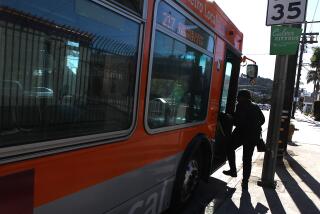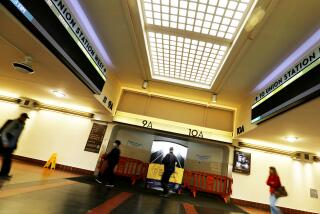Metro’s free ride may soon be over
A sign of things to come: The entrance turnstiles to the Red and Purple Metro lines at Union Station were locked (“latched,” in Metro-speak) Tuesday morning, forcing would-be riders to actually buy a ticket to get on the train.
What a concept.
The latch-down was part of the latest and largest operational test by Metro of the technology it will use to cut down on fare-beaters. Riders have been on the honor system thus far, forced to produce tickets (or more recently, plastic Transit Access Pass cards) only when sheriff’s deputies were there to demand them. Although Metro officials assumed that the vast majority of riders did, in fact, pay their fares, some critics were not so sure.
SLIDE SHOW: 10 reasons to salute L.A.’s transportation future
Early tests of the new system suggested the critics were right. In late 2011 and early 2012, trial runs with latched gates raised revenue at two popular Red Line stops by 18% to 22%, The Times’ Ari Bloomekatz reported. “Basically, when we latch, we see ridership dip a little and revenue go up,” David Sutton, Metro’s deputy executive officer of TAP, said in an interview Tuesday.
One key piece of the puzzle has been in place for a while: All the stations on the Red, Purple and Green lines have latchable turnstiles and gates, as do five each on the Blue and Gold lines. Metro is in the process of installing another piece, putting intercoms and cameras near the gates to help customers having trouble getting through. This equipment will let Metro officials open gates remotely if needed.
A third key piece is being tested now by Metrolink: tickets with an embedded microchip that can be used on both the Metrolink lines and the Metro trains. Those tickets will probably go into widespread use at the end of May, Sutton said. “They’ve tested it in some machines, they just don’t have their bulk product yet,” he added. “That’s one hurdle we’re still going toward, and all systems are go on that.”
So how are riders reacting? Sutton said Metro has staff standing by at the latched gates to help befuddled customers, “but people pick this up quite fast.” He added: “We’ve been [latching gates at] the Normandy station on a regular basis for several months. It’s just like clockwork there.”
The plan is to start latching gates permanently on June 19, although Sutton said Metro won’t do all the stations at once. Instead, it will phase in the change methodically to “help our customers get used to the idea.”
Once the latching is fully deployed, Metro will be able to redeploy its security forces to the light-rail stations whose designs won’t accommodate gates, Sutton said. But he acknowledged that latching won’t solve the fare-beating problem by itself. Unlike the New York subway system, which blocks its entrances with floor-to-ceiling barriers, the turnstiles and gates in Los Angeles can still be hurdled by the able-bodied. That means Metro will have to continue putting sheriff’s deputies on trains from time to time to check TAP cards and deter gate-jumpers.
Sutton said his hope is that Metro will never follow New York’s lead and install bars on its entryways from floor to ceiling. “I think our stations are really attractive,” he said. “I like our travel to be a positive experience.”
Positive but not free, that is.
ALSO:
3 million Californians could receive insurance subsidies
Follow Jon Healey on Twitter @jcahealey
More to Read
A cure for the common opinion
Get thought-provoking perspectives with our weekly newsletter.
You may occasionally receive promotional content from the Los Angeles Times.







